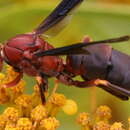en
names in breadcrumbs


Xenos is a genus of insects belonging to the family Xenidae.[1] The word derives from the Greek word for strange.[2] A species of the genus is Xenos vesparum, first described by Pietro Rossi in 1793.[3][4] The females are permanent entomophagous endoparasites of Polistes paper wasps. They dwell their whole lives in the abdomens of wasps.
These 33 species belong to the genus Xenos:[1]
Xenos is a genus of insects belonging to the family Xenidae. The word derives from the Greek word for strange. A species of the genus is Xenos vesparum, first described by Pietro Rossi in 1793. The females are permanent entomophagous endoparasites of Polistes paper wasps. They dwell their whole lives in the abdomens of wasps.

 Four male pupae are visible partially emerged from the wasp's abdomen; likely Xenos peckii, which is a parasite of the paper wasp Polistes fuscatus.
Four male pupae are visible partially emerged from the wasp's abdomen; likely Xenos peckii, which is a parasite of the paper wasp Polistes fuscatus.